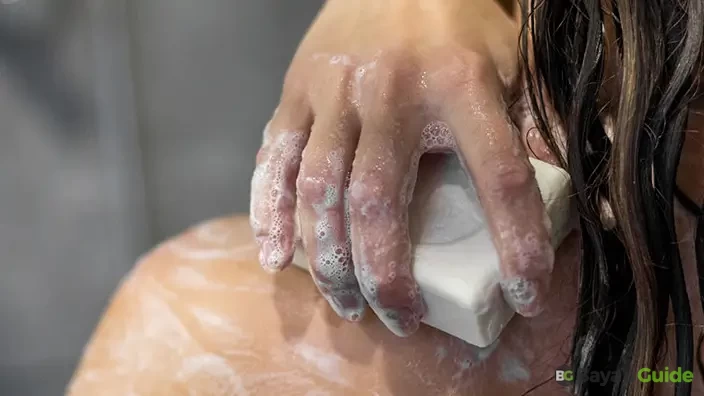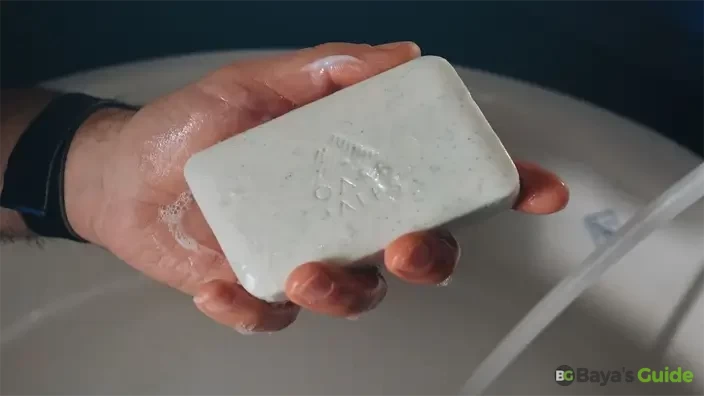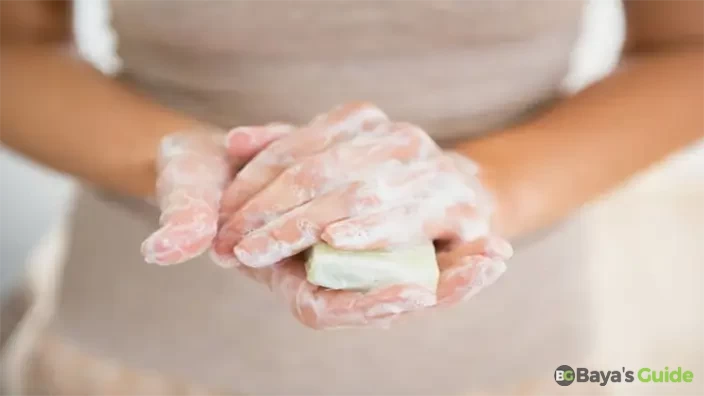In a world filled with elaborate skincare products and complex grooming routines, it's easy to overlook the humble bar of soap. Yet, this unassuming staple of personal hygiene holds remarkable potential for cleansing, nourishing, and revitalizing our skin. In this comprehensive guide, we delve into the art of using a bar of soap effectively to elevate your daily grooming ritual.
From selecting the right type of soap for your skin type to mastering the techniques of lathering and cleansing, we cover it all. Whether you're a seasoned soap enthusiast or a newcomer to the world of bar soap, this article will equip you with the knowledge and skills needed to make the most of this timeless cleansing agent. Join us as we explore the versatility, simplicity, and effectiveness of the soap bar, and discover how it can become your go-to solution for achieving clean, refreshed, and nourished skin.
Table of Contents
- The Art of Proper Bar Soap Application
- Unveiling Soap Varieties: Are They All Alike?
- Elevate Your Shower Experience: Tips For Using Bar Soap Effectively
- Essential Dos & Don'ts For Bar Soap Usage
- Vital Handwashing Guidelines
- Maximize Your Bar Soap's Lifespan - Key Strategies
- Examining The Health Effects Of Bar Soap
- How To Maintain The Cleanliness Of Your Bar Soap?
- Benefits Of Using Bar Soap
- Unveiling The Secrets Of Bar Soap Production
- Frequently Asked Questions
- Conclusion
Using bar soap effectively begins with selecting the right type of soap for your skin type and preferences. Wet your hands and the soap, then rub the bar between your palms or against a washcloth to create a rich lather. Gently massage the lather onto damp skin in circular motions, focusing on areas that need cleansing. Rinse thoroughly with warm water, ensuring no residue remains. Pat your skin dry with a soft towel and follow up with a moisturizer if needed. To prolong the life of your soap, store it in a well-drained soap dish away from water between uses. With these simple steps, you can harness the full potential of a bar of soap to keep your skin clean, refreshed, and nourished.
Unveiling Soap Varieties: Are They All Alike?
No, not all soaps are made equally or with the same materials. The composition of soap can vary widely depending on factors such as the manufacturing process, ingredients used, and intended use. Traditional bar soaps are typically made from a combination of fats or oils, water, and an alkaline substance such as sodium hydroxide (lye) through a process called saponification. However, the specific types of fats or oils, additives, fragrances, and other ingredients can differ significantly between different soap formulations.
Additionally, there are various types of soap available, including synthetic detergents (such as Syndet bars) and specialty soaps (such as glycerin-based or medicated soaps), each with its unique composition and properties. Therefore, it's essential to choose a soap that suits your skin type and preferences and to read ingredient labels carefully to understand what you're using on your skin.
1- Hose Down Your Body To Loosen the Dirt
Before you use bar soap, it is important to get your body wet so that all the dirt, filth, oil, and dead cells of your skin soften and wash away easily under the shower.
2- Use Warm Water Instead Of Hot Water
Avoid streamy showers as hot water damages your skin and melts your soap bar which may affect its use for a long time. Warm water makes your shower time enjoyable protecting your skin from getting dried up and also stays safe for the soap bar.
3- Lather Up
Suppose, a bar of soap is slow in making lather and can't rinse off the oil or dirt from your skin. Lather's cleansing ability is many-fold: Firstly, it smoothens the skin and helps water spread out on your body thoroughly. Secondly, the foam of the soap bar mixes well with grease and water and plucks out the oily and dirty bits from your body. So, to take the greater effect of soap bars, it’s better to rub between your hand palms to create lather foam instead of using it directly on your body. Additionally, you also rub your soap on cloth, soap mitt or loofah then apply a foamy lather object on your skin.
4- Thoroughly Apply Foamy Soap All Over Your Body
After creating foam on your shower accessory in abundance, rub it over and aside your body from top to bottom to ensure that the whole wash away effectively and gets cleaned thoroughly. You may lather up your loofah again if you need to.
5- Rinse Your Body & Loofah
If you are using a piece of cloth or a loofah to create a foamy lather, then rinse it thoroughly after washing your body. Make sure all the soap suds from the object and hang it to get it dry before your next use. You need to dry it thoroughly so that no nasty bacteria should stay inside.
Certainly! Here are some dos and don'ts to keep in mind while using bar soap:
Dos:
- Wet Your Hands & the Soap - Before using the bar soap, wet your hands and the soap to create a lather more easily.
- Create A Rich Lather - Rub the soap between your palms or against a washcloth to create a rich lather before applying it to your skin.
- Gently Massage Onto Damp Skin - Apply the lather to damp skin and gently massage it in circular motions, focusing on areas that need cleansing.
- Rinse Thoroughly - After cleansing, rinse your skin thoroughly with warm water to remove all traces of soap residue.
- Pat Dry With A Towel - Pat your skin dry with a soft towel rather than rubbing, which can irritate the skin.
- Store Properly - Store your bar soap in a well-drained soap dish away from water between uses to prolong its life.
Don'ts:
- Don't Use On Dry Skin - Avoid using bar soap directly on dry skin, as it can be less effective and may cause irritation.
- Don't Leave Soap In Standing Water - Leaving your bar soap in standing water can cause it to become soggy and dissolve more quickly.
- Don't Share Bar Soap - Avoid sharing bar soap with others to prevent the spread of bacteria and germs.
- Don't Use On Broken OR Irritated Skin - Refrain from using bar soap on broken, irritated, or sensitive skin, as it may exacerbate the condition.
- Don't Overuse - Using too much soap or cleansing too frequently can strip the skin of its natural oils and lead to dryness or irritation.
By following these dos and don'ts, you can make the most of your bar soap while ensuring effective and gentle cleansing for your skin.
Vital Handwashing Guidelines
- Frequent handwashing can cause soap bars to become damp, potentially affecting their longevity.
- To use soap bars effectively, start by rubbing the soap bar between your palms to create a foamy lather.
- Thoroughly rub the foam all around your hands and between your fingers for about 20 seconds.
- Scrub the lather onto every area of your hands, from the fingertips to the wrists and fingernails.
- Rinse your hands starting from the elbow down to the fingers to ensure no germs remain.
- Finally, dry your hands with a clean towel immediately after washing.
You Might Be Interested: How To Get Poop Stains Out Of Baby Clothes
To ensure your bar soap lasts longer, consider these tips:
1- Keep It Dry
Store your bar soap in a well-drained soap dish or holder between uses to prevent it from sitting in water and becoming mushy. This helps prolong its life and prevents it from dissolving too quickly.
2- Cut It Into Smaller Pieces
Consider cutting your bar soap into smaller pieces or using a soap-saver bag to extend its lifespan. Smaller pieces are easier to handle and use, and they tend to last longer than larger bars.
3- Rotate Use
If you have multiple bars of soap, rotate their use to give each bar a chance to dry out fully between uses. This prevents one bar from getting soggy while the others dry out.
4- Store In A Cool & Dry Place
Avoid storing your bar soap in humid or excessively hot environments, as this can cause it to soften and dissolve more quickly. Instead, keep it in a cool, dry place to maintain its consistency and longevity.
5- Let It Cure
Allow newly purchased or freshly made bar soap to cure for a few weeks before using it. This helps the soap harden and dry out, making it last longer when you start using it.
6- Use A Soap Saver Dish OR Bag
Consider using a soap-saver dish or bag, which helps keep your bar soap dry between uses and prevents it from sitting in water.
7- Use A Washcloth OR Sponge
Using a washcloth or sponge to lather the soap rather than rubbing the bar directly on your skin can help reduce waste and make the soap last longer.
By following these tips, you can maximize the lifespan of your bar soap and get the most out of each bar.
Bar soap is generally considered safe and effective for cleansing the skin when used properly. However, some people may have concerns about the hygiene of bar soap, particularly in shared or public settings where multiple people may use the same bar. While bar soap itself is not inherently unhealthy, there are a few considerations to keep in mind:
1- Bacterial Transmission
When bar soap is used by multiple people, there is a risk of bacteria transfer from one person to another. However, research suggests that the risk of contracting an infection from using shared bar soap is minimal, as the soap's cleansing action and the rinsing process help remove bacteria from the skin.
2- Proper Hygiene Practices
To minimize the risk of bacterial contamination, it's essential to store bar soap in a clean, dry place between uses and to avoid leaving it in standing water. Additionally, using a soap dish with proper drainage can help keep the soap dry and prevent bacterial growth.
3- Individual Sensitivities
Some individuals may be sensitive to certain ingredients or fragrances found in bar soap. If you have sensitive skin or specific allergies, it's essential to choose a soap that is suitable for your skin type and preferences.
Note: Overall, bar soap can be a safe and effective option for correctly cleansing the skin. However, individuals with specific concerns or sensitivities may prefer alternative cleansing products such as liquid soap or syndet bars (synthetic detergent bars). As with any personal care product, it's essential to choose the option that works best for your needs and preferences.
Ensuring the optimal usage of your bar soap begins with keeping it clean. Here's how:
- Thorough Rinsing - After each use, rinse the soap bar under running water to remove all residues thoroughly. This prevents the buildup of germs and ensures a fresh lather for the next use.
- Keep It Dry - Store your soap bar in a location where it won't be exposed to water between uses. A dry environment maximizes the lifespan of the soap and prevents it from becoming mushy or slimy.
- Use An Absorbent Surface - Place your soap bar on a sponge or absorbent cloth to help soak up any excess water and keep the soap dry between uses. This further enhances its longevity and effectiveness.
Additionally, assigning specific soap bars for each family member not only promotes hygiene but also ensures the longevity of the soap. Each member can use their designated soap bar, contributing to their individual skincare needs and overall health.
Bar soap offers numerous advantages for personal hygiene and skincare:
- Effective Cleansing - It efficiently removes dirt, oil, and impurities from the skin, leaving it clean and refreshed.
- Versatility - Suitable for cleansing the entire body, including the face, hands, and body, making it a convenient option for daily routines.
- Longevity - When stored properly, bar soap can last for an extended period, making it cost-effective compared to other cleansing products.
- Environmentally Friendly - Minimal packaging reduces waste and plastic consumption, making it an eco-friendly choice.
- Moisturizing Properties - Many bar soaps contain moisturizing ingredients that hydrate and nourish the skin while cleansing.
- Variety Of Formulations - Available in diverse formulations to suit different skin types and preferences.
- Portability - Easy to travel with due to its compact size and solid form.
Moreover, bar soap is waterless, offering efficient storage and conservation of water. It allows users to choose formulations tailored to their specific skin type, addressing concerns such as oily, dry, sensitive, or combination skin. Additionally, bar soap serves various purposes beyond cleansing, including relieving bug bites, freshening smelly shoes, and maintaining clean fingernails. It can even be used for shaving, providing a simple yet effective alternative to traditional shaving creams or gels.
Incorporating bar soap into your skincare routine not only promotes cleanliness but also offers numerous benefits for overall skin health and hygiene.
The process of making bar soap involves a chemical reaction called saponification, which occurs when fats or oils are combined with an alkaline substance, such as sodium hydroxide (lye) or potassium hydroxide. Here's a simplified overview of the soap-making process:
1- Selecting Ingredients
Soapmakers start by selecting the fats or oils they want to use in their soap recipe. Common oils include coconut oil, olive oil, palm oil, and shea butter. Each oil has unique properties that contribute to the final characteristics of the soap.
2- Measuring & Mixing
The chosen fats or oils are carefully measured and mixed together in the desired proportions. This mixture forms the base of the soap.
3- Preparing Lye Solution
Sodium hydroxide (for solid soap) or potassium hydroxide (for liquid soap) is dissolved in water to create a lye solution. This solution is highly caustic and must be handled with care.
4- Combining Ingredients
The lye solution is slowly added to the oils while stirring continuously. This process, known as saponification, causes the fats and lye to react chemically, forming soap and glycerin.
5- Adding Fragrance & Additives
Fragrance oils, essential oils, colorants, and other additives may be added to the soap mixture to enhance its scent, appearance, and skincare properties.
6- Pouring & Molding
Once the soap mixture reaches a thick, pudding-like consistency known as "trace," it is poured into molds. The molds can be made of various materials, such as silicone, plastic, or wood.
7- Curing
The soap is left to cure and harden in the molds for several weeks. During this time, the remaining lye in the soap undergoes further chemical reactions, ensuring that the soap is mild and gentle on the skin.
8- Cutting & Packaging
After curing, the soap is removed from the molds and cut into individual bars. The bars are then allowed to air dry fully before being packaged and labeled for sale.
Note: The soap-making process requires precision, careful measurement, and adherence to safety guidelines, particularly when handling lye. Experienced soapmakers may also experiment with different oils, additives, and techniques to create unique and customized soap formulations.
Frequently Asked Questions
Before using the bar of soap, wet your hands or the area of your body you want to wash with warm water. This helps to soften the skin and prepares it for cleansing. Take the bar of soap in your hands and rub it gently between your palms or against a washcloth to create a rich lather. Alternatively, you can rub the bar directly onto your wet skin to produce a lather.
If desired, apply a moisturizer to your skin after washing to help keep it hydrated and nourished, especially if you have dry or sensitive skin.
How Long Should I Lather The Soap Before Rinsing?
There's no set time for lathering soap, but it's generally recommended to lather for at least 20-30 seconds to ensure thorough cleansing. However, you can adjust the lathering time based on your preferences and the areas you're washing.
Yes, bar soap can be used on the face, but it's essential to choose a gentle formula that is suitable for facial skin. Avoid using harsh or overly drying soaps, especially if you have sensitive skin.
Store your bar soap in a well-drained soap dish or holder between uses to allow it to dry out and prevent it from becoming mushy. Avoid leaving it in standing water, as this can cause it to dissolve more quickly.
Conclusion
There's one point that goes in favor of soap bars their demand has been increasing in all these years. It has been approved as the most effective product through wide worldwide usage with full hygiene that keeps your skin clean and healthy. Beyond keeping your skin fresh and fit, it comes with numerous benefits such as clean skin; original skin; additional healthy skin, and also smells great. We’d love to know your opinion and feedback after using the soap bar, also we'd love to respond if you have any questions regarding the usage and type of soap- type here down in the comments area. Thanks for your time and attention!























